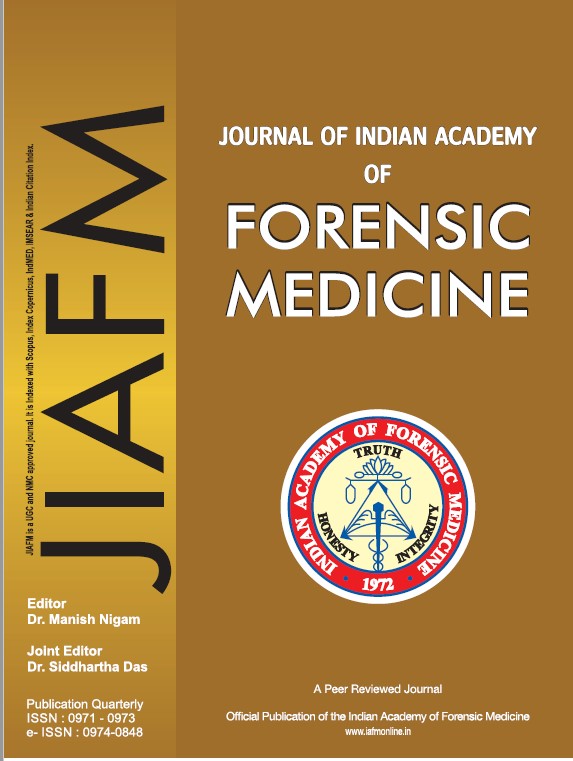The Estimation of Time since Death by Rule of Thumb method Applied to the Corpses Brought to the Mortuary, GGH, Guntur
DOI:
https://doi.org/10.48165/jiafm.2023.45.4.4Keywords:
Core temperature, Deep central temperature, Diurnal variationAbstract
A physical change that may occur in a corpse after death would be heat exchange from the body to the surrounding environment. An attempt has been made by the investigators to estimate time since death by Rule of thumb method which takes into account the rate of fall of temperature. Atotal of 100 human corpses selected for the study. The study was conducted from January to March of the year 2022. It is very difficult to specify normal body temperature, as this value can vary considerably between individuals. Rectal temperatures in a group of healthy subjects can vary between 34.2 C- 37.6 C, with a mean 36.9 C. Rectal temperature is often referred to as deep central temperature, similar in value to that of brain, heart, lungs and abdominal organs.
Downloads
References
Reddy KSN, Murthy OP. The Essentials of Forensic th Medicine and Toxicology. 35 Ed. New Delhi. JAYPEE Brothers Medical Publishers (P) Ltd; p113.
Aggrawal A. Essentials of Forensic Medicine and Toxicology. st 1 ed. Delhi: Avichal Publishing Company; 118: 1-6p.
Knight B. The evolution of methods for estimating the time of death from body temperature. Forensic Sci. Int. 1988; 36: 47- 55. 1988 Jan;36 (1-2): 47-55.doi: 10.1016/0379-0738(88) 90214-9. Retrieved on 06-6-2022.
Lundquist F. Physical and chemical methods for the estimation of the time of death. Acta Med. Leg Soc. 1956: 9: 205-13. Available from: https://pubmed.ncbi.nlm.nih. gov/13434819/
Nokes L, Hicks B, Knight B. The post-mortem temperature plateau – fact or fiction. Med. Sci. Law. 1985; 25: 263-4.
Hutchins G. Body Temperature is elevated in the early post mortem period. Hum. Pathol. 1985: 16: 560 -1. 1985 Jun;16(6): 560-1.doi: 10.1016/s0046-8177(85)80104-0., retrieved on 06-6-2022.
Marshall T, Hoare F. Estimating the time of death - the rectal cooling after death and its mathematical representation. Forensic Sci. 1962; 7: 56-81.
James W, Knight B. Errors in estimating time since death. Med. Sci Law.1965; 5:111-16. doi: 10.1177/00258024650
represents the period of fast
The cooling of a human corpse does not follow the Newton's law of cooling and it is adequately described by a double exponential formula, and the shape of the curve is a sigmoid one. The initial
stages of cooling reported a “lag period” known as temperature plateau for a variable length on the cooling curve; the calculated
Joseph A. Schiekele A. A General method for assessing factors controlling post mortem cooling. J Forensic Sci. 1970: 15: 364 - 91.
Lyle H, Cleveland F. Determination of the time since death by heat loss. J. Forensic Sci. 1956, 1: 11-24.


